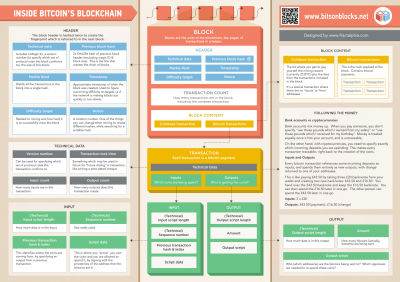Anatomy of a Block
Category: Block(s) - a closer look
Tags: bitcoin, block, hash, header, timestamp
Description: The anatomy of a blockchain block consists of several key components, each playing a crucial role in ensuring the integrity, security, and functionality of the blockchain network. Below is a detailed explanation of the components typically found in a blockchain block:
-
Block Header:
- The block header is a vital component at the beginning of each block and contains metadata about the block itself.
- Components of the block header include:
- Version: The version number of the block format.
- Previous Block Hash: A reference to the hash of the previous block in the blockchain, creating a chronological chain of blocks.
- Merkle Root: The Merkle root is a hash of all the transactions included in the block, providing a single, compact representation of the transactions.
- Timestamp: The timestamp indicates the time when the block was created or mined.
- Nonce: A nonce is a random number used in the mining process to find a valid block hash that meets the network's difficulty target.
- Difficulty Target: The difficulty target specifies the level of difficulty required for a block hash to be considered valid, ensuring that blocks are mined at a consistent rate.
-
Transactions:
- Transactions are the actual data stored within the block and represent the changes made to the blockchain ledger.
- Each transaction contains information such as:
- Sender and Receiver Addresses: The addresses of the sender and receiver involved in the transaction.
- Amount: The amount of cryptocurrency or asset being transferred in the transaction.
- Transaction ID: A unique identifier for the transaction.
- Input and Output Scripts: Scripts containing cryptographic signatures and conditions required for validating the transaction.
- Transactions can include various types of data, from simple cryptocurrency transfers to more complex smart contract interactions and token transfers.
-
Block Height:
- The block height indicates the position of the block within the blockchain's chronological order.
- Each block is assigned a unique block height, with the first block in the blockchain (genesis block) typically having a height of 0 or 1.
-
Block Size and Weight:
- The block size refers to the total amount of data stored within the block, including the block header, transactions, and any additional metadata.
- Block weight is a measure of the computational resources required to validate and process the block, taking into account factors such as transaction size and complexity.
-
Block Reward:
- The block reward is an incentive provided to miners for successfully mining and adding a new block to the blockchain.
- It typically consists of newly minted cryptocurrency tokens (e.g., Bitcoin) and transaction fees collected from the transactions included in the block.

Loading...
